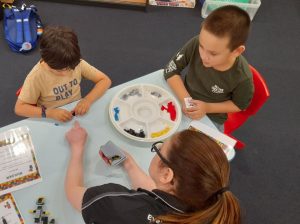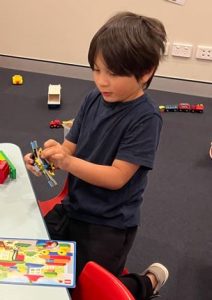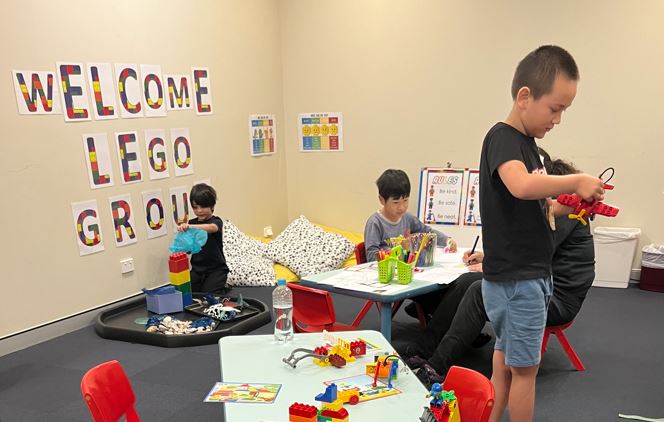LEGO® is one of the most imaginative toys developed for children. Nearly a hundred years later, it’s still as popular as ever!
LEGO®-based groups bring young autistic children and children with other disabilities together through a shared interest in LEGO® play. The groups offer a unique learning opportunity to create positive social experiences, connect with others over a shared interest, improve emotional well-being and develop friendships.

Autistic children can find it challenging to understand what to do in a social situation. By building and playing together, children collaborate, communicate, negotiate and problem-solve in a safe and fun environment while developing new friendships.
LEGO®-based groups provide a highly structured environment for play. Autistic children feel calm and relaxed because they are doing something they enjoy. Plus, they know what to expect and what’s expected of them.

The Kites’ LEGO®– School Holiday Program centres on the principles of LEGO®-Based Therapy, developed by US paediatric neuropsychologist Daniel LeGoff in the mid-1990s. LEGO®-Based Therapy (link opens in new window) is evidence-based learning through an approach that aims to develop social communication skills in children through collaborative play.
The program takes place over four days for three hours every day. Registered Kites Psychologist Kristie Robins, a Certified Facilitator of LEGO®-Based Therapy, runs the program along with Therapy Assistant Lisa Goodwin.
Why does each child have a role?
During a session, children work in teams to complete a LEGO®– project. Children are assigned one of three roles, Engineer, Supplier, or Builder and take turns assuming responsibility. Each child must follow group rules and rules about their specific role.
- The Engineer reads the instructions and is responsible for giving directions to others. The Engineer must tell the Supplier what pieces they require and tell the Builder how the blocks go together. Specifically, they need to advise the Supplier: What type of brick do they need first? What shape? What colour and what size?
- The Engineer then needs to tell the Builder: Where to put the bricks (for example, on top, under or next to, or behind). Which bricks to use – including size, colour, and shape (for example, the small, blue rectangle).
- As an Engineer, children learn sentence structure, descriptive language, accuracy, patience and adaptability.
- The Supplier sorts through and finds the right pieces for the Builder. The Supplier must listen to the Engineer and figure out what blocks to retrieve so he can give these pieces to the Builder.
- As the Supplier, children learn listening skills, searching and identification, descriptive language, adaptability, flexibility and how to ask for help.
- The Builder– puts the pieces together according to the directions. The Builder must listen to the instructions from the Engineer to receive pieces retrieved by the Supplier.
- The Builder learns, listens and responds to instructions. They have to coordinate and plan with others. They are more aware of prepositions by following directions. By building the blocks, they are working on fine motor skills.

LEGO® can benefit autistic children in many ways
How will a LEGO®-based group benefit my child?
The Kites LEGO® Group School Holiday Program can benefit young autistic children and children with other disabilities by:
- Developing communication skills through expressing ideas and thoughts by promoting active listening, expressing opinions and delivering instructions. LEGO®-based group sessions help to build negotiation skills to achieve a common goal.
- Supporting emotional regulation. Building objects with LEGO® bricks can provide an outlet for expression, so a child can collaborate with others, share ideas, handle disagreements and manage emotions.
- Building both perseverance and resilience. Sometimes the LEGO® model will not go to plan, leading to disappointment. Through LEGO®-based groups children learn to try again, develop resilience and bounce back from adversity or disappointment.
- Improving social skills. LEGO®-based groups are an ideal way to practice and perfect social skills. Children learn how to start and maintain conversations, respect other people’s opinions and work as a team.
- Supporting empathy. Participating in LEGO®-based groups can lead to increased compassion and understanding of others.
- Developing self-esteem. LEGO®-based groups can help by providing a safe space for children to learn new activities, build confidence in approaching new tasks.
- Investigating problem-solving. LEGO®-based group sessions give children a platform to find solutions and problem solve together to develop independence and resilience for the future. Each session develops critical thinking skills, creativity and the ability to analyse solutions from various perspectives.
- Encouraging turn-taking. During LEGO®-based group sessions turn-taking develops in a structured way. Children take turns to experience different roles and to give and receive instructions, developing a child’s ability to share and work as a team.
- Supporting fine motor skills. Practicing fine motor precision and hand-eye coordination through the brick building projects.
How to get involved
To investigate the power of play with LEGO® bricks and to register your place on the School Holiday Program visit: Kites’ LEGO®-based page.

